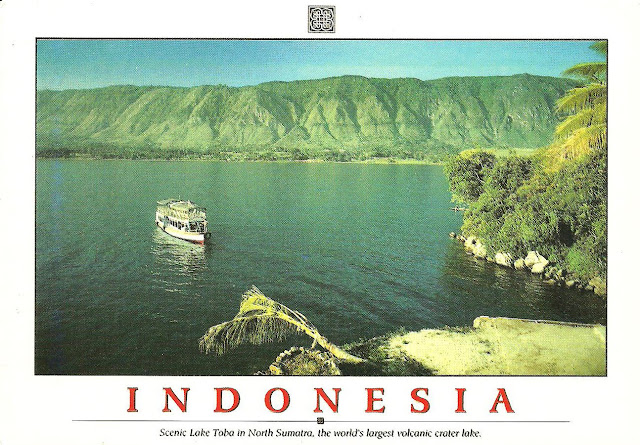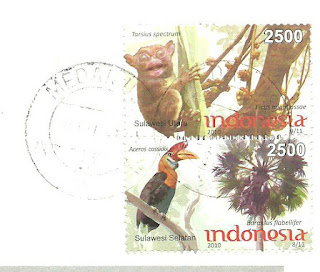Edwin from Indonesia contacted me via this blog to swap with me, making it the second succesful swap thanks to this site. We agreed on swapping 2 cards and I was very happy to receive these in my mailbox today!
Prambanan is a collection of massive Hindu temples (candi) built by the Mataram Kingdom, rulers of central Java and defeaters of the Sailendra Dynasty.
A UNESCO World Heritage Site, in almost any other country a magnificent ancient monument on the scale of Prambanan would quickly be designated a national symbol. In Indonesia though it is somewhat overshadowed by the even more awe-inspiring nature of nearby Borobudur. The two sites are quite different in style with Hindu Prambanan being a collection of sharp, jaggedly sculpted towers in contrast to the vast horizontal bulk of Buddhist Borobudur.
A temple was first built at the site around 850 CE by Rakai Pikatan and expanded extensively by King Lokapala and Balitung Maha Sambu the Sanjaya king of the Mataram Kingdom. According to the Shivagrha inscription of 856 CE, the temple was built to honor Lord Shiva and its original name was Shiva-grha (the House of Shiva) or Shiva-laya (the Realm of Shiva). According to Shivagrha inscription, a public water project to change the course of a river near Shivagrha Temple was conducted during the construction of the temple. It is therefore slightly later but more or less contemporaneous with Borobudur. In the 10th century the temple was largely abandoned after the Mataram dynasty moved its court base to East Java.
Most of the main temples collapsed during a major earthquake in the 16th century and the huge complex lie largely forgotten in the jungle. Following the Anglo-Dutch Java War, Java was briefly under British administration from 1811 to 1816. In 1811, a surveyor working for Thomas Stamford Raffles came upon the ruins of Prambanan by pure chance. It is somewhat ironic that the very brief British rule of Java led to the re-discovery of both Borobudur and Prambanan. The British and Raffles were not in power in Java long enough to really do much about Prambanan though and looting became rife with Dutch residents adorning their gardens with priceless statues and local people taking foundation stones and using them as construction material. Proper restoration began only in 1930 and still continues today. [source: wikitravel.org]
Lake Toba is an immense volcanic lake covering an area of 1,707 sq km (1,000 sq km bigger than Singapore) with an island in the center. Formed by a gigantic volcanic eruption some 70,000 years ago, it is probably the largest resurgent caldera on Earth. Some studies say it might have been associated with causing previous ice age/climate change and the largest human population bottleneck ever. Genetic estimates suggests that there were only a few thousand individuals that survived the catastrophe. The island in the middle - Pulau Samosir - was joined to the caldera wall by a narrow isthmus, which was cut through to enable boats to pass; a road bridge crosses the cutting. Samosir island is the cultural centre of Batak tribe who are mostly Christians in the modern days.
Lake Toba was perhaps once more popular than it is nowadays, but for many it remains a firm fixture on the Banana Pancake Trail. It is a great laid back place to chill out for a few days after jungle trekking etc. The location is very popular with Chinese tourists around Chinese New Year, when availability drops dramatically and accommodation costs sky rocket. [source: wikitravel.org]
Thank you very much Edwin!




Geen opmerkingen:
Een reactie posten